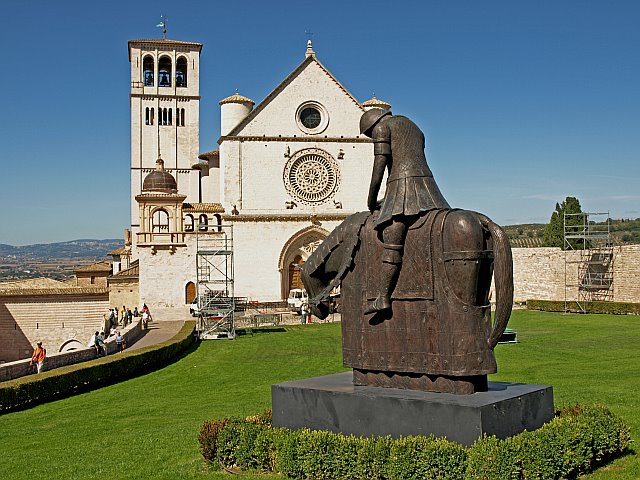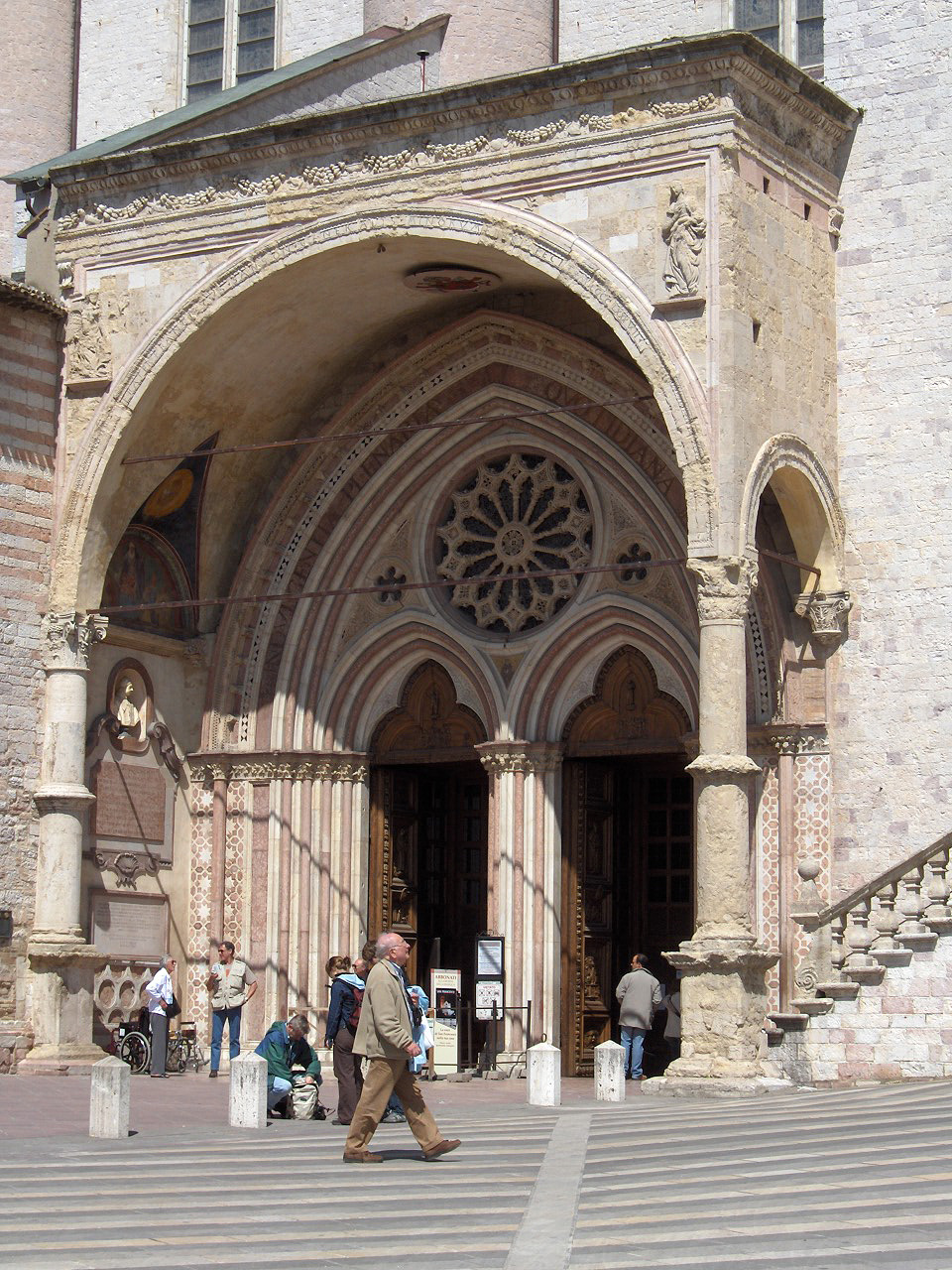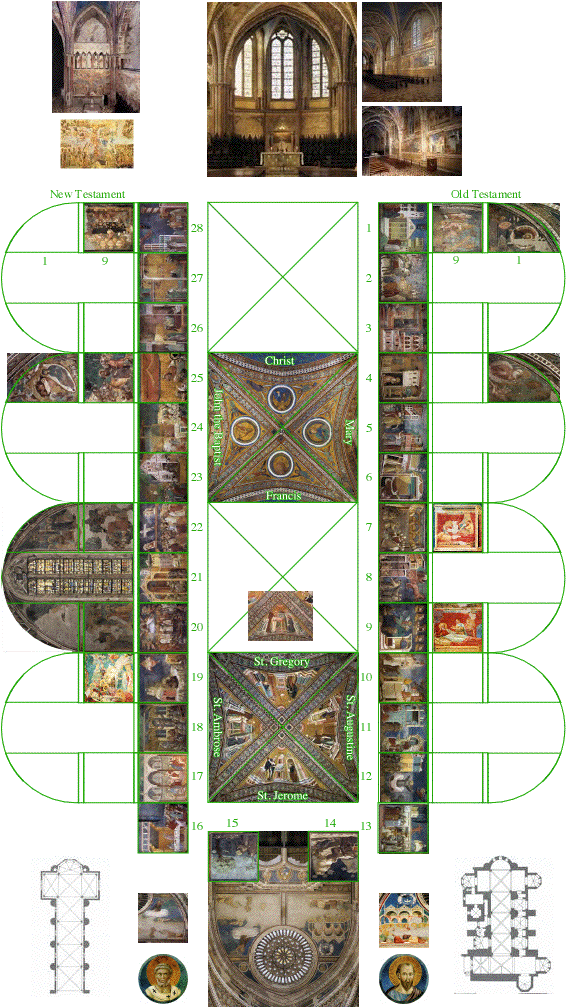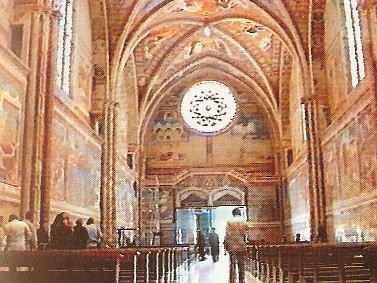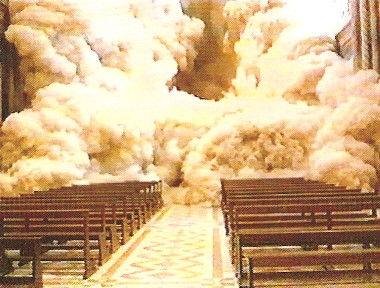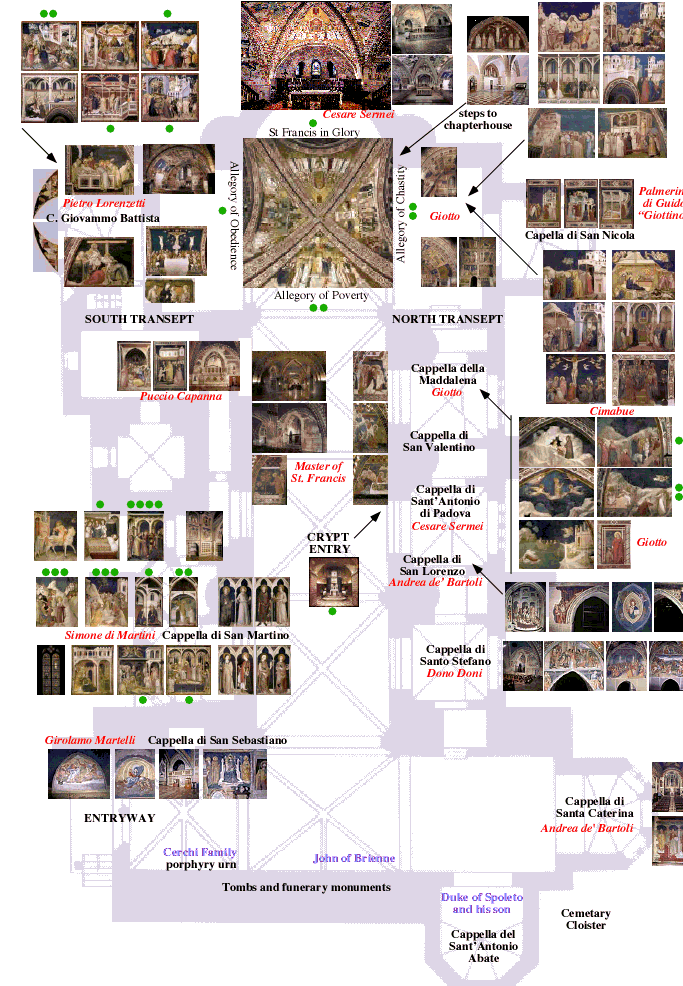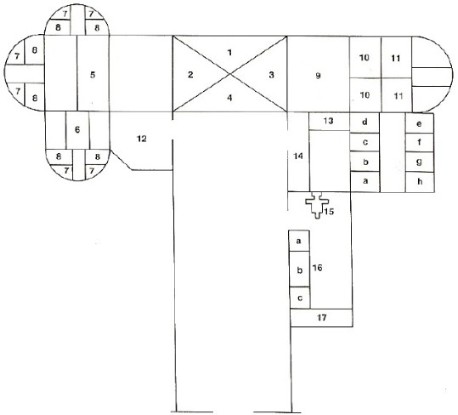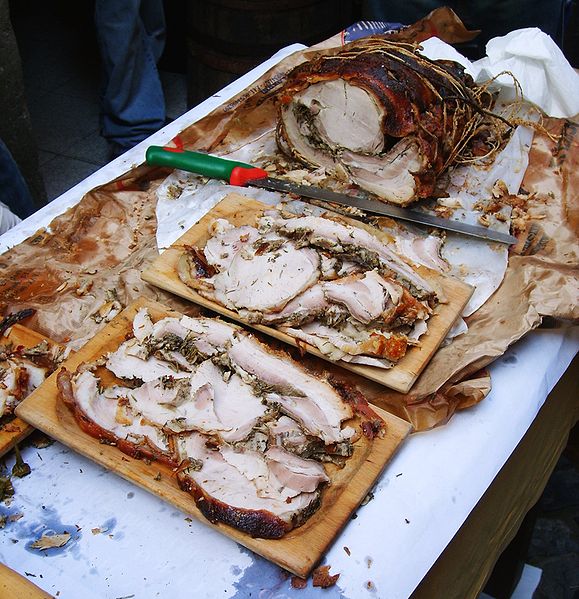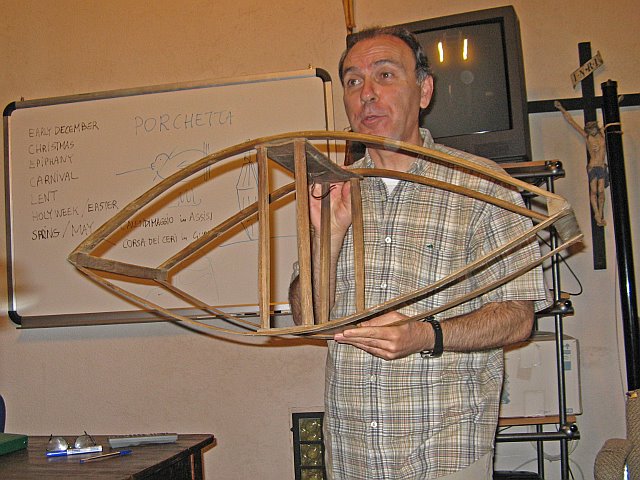|
Francis was buried here, after his death in the Porziuncola, and he was also canonised here. His remains lay here for four years before being moved to his Basilica. St. Clare is buried here in the crypt. The church was built in 1257 in Italian gothic style (also known as "Franciscan" style), and was consecrated in 1265. The extremely simple façade consists of horizontal layers of pink and white stone, and there are two lions at the sides of the portal.
Umbrian traditions
This afternoon Marco delivered comments on Umbrian traditions. I have elsewhere presented one such tradition, associated with the Palio of Siena. There are several peculiar to Umbria, with comparable representation by neighborhoods which show their pride through flags and associated ceremonies. Here are two examples.
For its Calendimaggio (online images) Assisi is divided into Lower and Upper parts, and each of these is divided into three rioni (districts). Each rione has its own flag and shield. There's an interesting illustration of this setup here
The Calendimaggio celebrations in Assisi trace their roots back to very ancient customs of celebrating spring that were used by civilisations even outside the Italian peninsula. These traditions were later transformed into celebrations of the goddesses Maia and Flora by the Romans, and later still into the Kalende di Maggio celebrations during the Middle Ages. Groups of young gaudentes sing, dance and serenade their way through the city's streets and squares as a means of celebrating the return of spring.
In Assisi the festivities are also linked to the centuries-old rivalry between the "Parte de Sotto" and the "Parte de Sopra" areas of the city. In 1300 the two factions, led respectively by the Fiumi and the Nepis families, engaged in a long and bloody struggle for supremacy that lasted for over two centuries.
On the last evening of the festivities the "Palio" is awarded in the neautral ground of Piazza del Comune by a jury made up of historians, directors and musicologists. The jury decides which of the two "Parti" has best interpreted the celebrations of the return of spring. source
There are some videos of the ceremonies here and here
 |
The gonfalon is red and bears the arms in the upper centre. The arms are those of Fiumi family, once a leading force of the Guelph faction in the area. The gold tower is placed on green stripes for land and has a blue river issuing from the base. As the name "Fiumi" translates as "rivers", the link is obvious. The gonfalon's lower edge has three tails for the three component rioni.
|
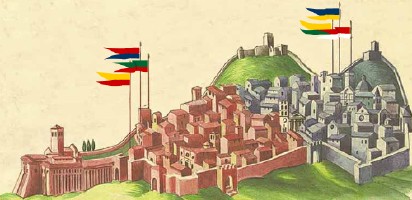 |
|
The arms are a red edged white shield ith a three-towered castle supported by two cats, emblem of the Mammoni family, a family associated with the mediaeval Ghibelline faction, which controlled the Upper Part, The three-step cut in the lower edge represents the three towers of the castle.
|

|
|
 San Pietro
San Pietro
Saint Peter was the first Pope. A fisherman by trade, his name was Simon until Christ called him "Peter" meaning the Rock and gave him the keys of the Kingdom of Heaven. Each of these attributes is shown in the shield. The gonfalon has the arms in the upper left corner and divides the livery colours by a wavy line, repeated in the shape of the bottom edge.
|
 San Francesco
San Francesco
This area surrounds the basilica of Saint Francis. The truncated cross was adopted as an ebmblem by the Franciscan Order during the Saint's lifetime. It stands on three hills connected to the saint (Mt. Subasio, Mt. Ingino, Mt. Verna). The three stars may represnt the Trinity, the three Franciscan orders or the first three men to join Francis. The gonfalon reverses the city's colours, and the lower edge recalls the three hills on the arms.
|
 San Giacomo
San Giacomo
The arms are green with a broad white diagonal stripe. Overall is a red tower pierced by a spear. This recall the church of San Giacomo de Muro Rupto (St. Jacob of the broken wall), from ehich the rione takes uts name. The arms appear in the upper right corner of the gonfalon. This is divided diagonally ascending red over green, the line seperating the colours being serrated like a crenellation, reinforcing the idea of the tower on the arms.
|
|
|
|
Adrian House (Francis of Assisi: A Revolutionary Life) notes that when he was a boy Francis could have learned all he needed to know about social structure by walking from the Rocco Maggiore, on top of the hill, through town to the gate at the bottom. The Rocco (fortress) belonged to the German Emperor and was lived in continuously by his envoy the Duke of Spoleto with a powerful garrison. Just below were the feudal lords and knights (whose castles were in the country). The cathedral and its bishop shared this level. Below was the central piazza, with city hall and business establishment. Below this were the stalls, workshop, ovens, slaughterhouses, hovels, tenements, leper houses, places of execution. The ceremonies served to remind everyone of this social reality.
Gubbio has its Festival of the Ceri (candles), May 15. This takes place every year on the eve of the feast of the patron Saint, Ubaldo. The “Ceri” are three tall, heavy wooden structures on top of which are placed the statues, respectively, of Sant’ Ubaldo (St. Ubald, protector of masons), San Giorgio (St. George, protector of merchants) and Sant’Antonio Abate (Abbot St. Antony, protector of muleteers and peasants). These structures are fixed on to frames (“barelle”), which the Ceri bearers (“ceraioli”) carry on their shoulders while running through the streets of the town and up to the Basilica of Sant’Ubaldo, near the top of Monte Ingino. An evocative ritual takes place before the race. At midday on Piazza Grande one can witness the spectacular raising (“alzata”) of the Ceri; immediately afterwards the Ceri complete three laps of the square at high speed, and then parade separately round the streets of the city. Then all three of them pause in Via Savelli, where they remain until the race starts. In the afternoon a procession bearing the statue of Sant’Ubaldo comes out of the Cathedral, and goes to the top of Via Dante, where the Bishop blesses the Ceri; that is the signal for the beginning of the frantic race. After having run through the main streets of the town, they go back to Piazza Grande and do three more laps (“birate”), before reaching the Porta dell’Angelo (known also as Porta di Sant’Ubaldo), where they start climbing up Monte Ingino. The Ceri are placed inside the basilica of Sant’Ubaldo, whereas the small statues of the three Saints are brought back into town in torchlit procession, accompanied by chanting. It is possible that this festival has its roots in ancient pagan rites, but its Christian character and its celebration of Sant’Ubaldo are historically proven and documented. source
In addition to such traditional festivals, Marco described "porchetta" (pron. por-KAY-tah). Every December whole pigs are roasted. Every part is edible and it can be stored for a long time. "Maiale" ("pig") derives from "Maia", one of the goddesses of Spring. He also told us about Francis instituting the first creche (nativity scene). He took great delight in telling us about Strozzapreti (priest strangler - a kind of thick spaghetti made in Umbria with just flour and water. The name is suggestive of Umbrian anticlericalism, which is rampant in the region (Cardinal Ugo Poletti once lamented, "The Italians are Catholic but anti-clerical at one and the same time"). Finally, he explained the device which had been hanging in our classroom. Turns out it was a bedwarmer. You hung a pot of hot coals within it. It was called the "prete" (priest) because it was in and out of every bed in town.
Further exploring
After Marco's presentation Karen and I did some more exploring on our own. We set out in search of the 12th century Chiesa di Santo Stefano (for patronymic reasons) and found it west of the Comune, down a lot of stairs, tucked in the hillside. It's at the corner of Via Santo Stefano and Via Bernardo da Quintavalle. A delightful, simple place. It has a very short single nave with the semicircular apse. There is a very restful, small garden adjoining the church.
On our way back up the hill toward the Comune we were hailed by ladies selling lottery tickets for the Italian Red Cross. We bought one for 2 Euros and won a plaque of St. Francis and St. Clare. Several storefronts away I spotted the same plaque in a window. The price was ... 2 Euro!

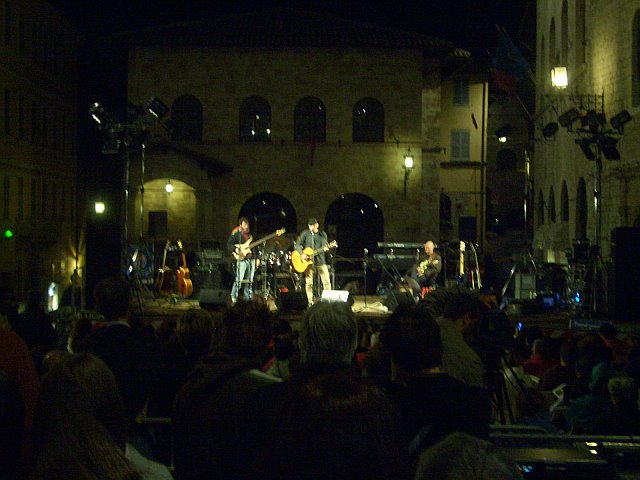
 After dinner we walked up to the Comune with Frank to watch some of the (pretty good) rock concert for which they had set up the platform yesterday in front of the Chiesa S. Maria Maggiore, aka Temple of Minerva. It's part of a week-long 12th annual U.N. International Peace Festival. There were reminders on all sidewalks of how much such movements are needed: chalkmarks indicating that the potential terrorist site had been checked and found safe for the Pope's recent "pastoral" visit to Assisi, the real purpose of which was to crush Franciscan autonomy. Had fun watching the young Italians do what young Italians do (drinking, dancing, love-making). After a while Karen and I needed to sit down. We walked back and had a very nice glass of wine at the MagnaVino, the little place next to the hotel, then went home.
After dinner we walked up to the Comune with Frank to watch some of the (pretty good) rock concert for which they had set up the platform yesterday in front of the Chiesa S. Maria Maggiore, aka Temple of Minerva. It's part of a week-long 12th annual U.N. International Peace Festival. There were reminders on all sidewalks of how much such movements are needed: chalkmarks indicating that the potential terrorist site had been checked and found safe for the Pope's recent "pastoral" visit to Assisi, the real purpose of which was to crush Franciscan autonomy. Had fun watching the young Italians do what young Italians do (drinking, dancing, love-making). After a while Karen and I needed to sit down. We walked back and had a very nice glass of wine at the MagnaVino, the little place next to the hotel, then went home.
|

